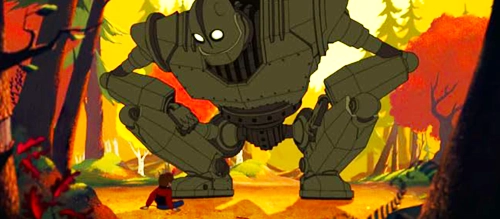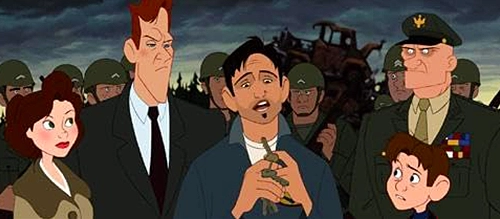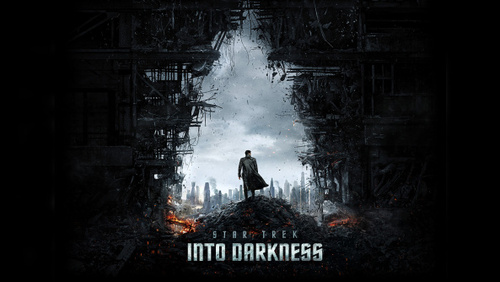
The Iron Giant (1999)
Director: Brad Bird
Screenwriters: Tim McCanlies, Brad Bird
Starring: Eli Merienthal, Harry Connick Jr., Jennifer Aniston, Vin Diesel, Christopher McDonald, John Mahoney, Cloris Leachman, M. Emmet Walsh, James Gammon
Brad Bird’s feature directorial debut deserves to be spoken about in the same breath as the greats of animation. After 25 years, technology may have leapt forward several times, but The Iron Giant still has the power to inspire awe and hit you with an emotional wallop.
Preserving the main story beats of the 1968 Ted Hughes children’s novel “The Iron Man”, but adding depth and interest by transposing events to 1950s small town USA, The Iron Giant follows lonely nine-year-old Hogarth Hughes (Eli Merienthal), who is desperate to find a real friend so he doesn’t always have to rely on his overactive imagination when making up stories inspired by cheap sci-fi movies. One night, while his single mother (Jennifer Aniston) is working late at the local diner, Hogarth goes searching for an object that has crashed off the coast of his town in Maine and his world is rocked when it turns out to be a curious giant robot (Vin Diesel) who attracts the attention of a shady US government agent (Christopher McDonald).
Brad Bird recounts that, in the 1990s, “No studio would let me take off. And I was told often, no animated feature will make over $50million dollars, and only a Disney film will make anything close to that, so there’s no reason why we would get into feature animation.”
Despite a slow decline through the 1980s, Disney was still the main name in town when it came to big screen family animation in this era. Having previously worked on ‘The Simpsons’ and for Disney under an internship programme, Brad Bird helped kick-start something over at Warner Bros: for the first time, the animation house who’d had decades of success on the small screen with the likes of ‘Looney Tunes’ and ‘Batman: The Animated Series’ would attempt to compete with Disney on the big screen. That The Iron Giant was made at all is all the more incredible when you consider how Disney and the up-and-coming Dreamworks (which had already made The Prince of Egypt and would soon release Shrek) were engaging the majority of animation talent in the United States. Warner Bros had a real mountain to climb with half the time and budget of a Disney feature, as well as a team of unproven, outcast or retired artists.
The Iron Giant, like a lot of animated films, probably maintains its strongest connection with audience members who grew up with it, who were about Hogarth’s age when it was released and either saw it on the big screen, or more likely on its home video or network TV release after the Warner Bros marketing department finally got their act together to actually promote it with TV spots from the likes of the Giant himself, Vin Diesel.
The Giant’s core moral dilemma – that of a weapon of war finding a more peaceful purpose, succinctly summed up by “I am not a gun” – packs an added punch not only because of the era of uncertainty the film is set in but because of the very personal reason that Brad Bird’s family had been a victim of gun violence with the loss of his sister only a few years before. Bird has stated that this event was the idea that really brought the story to life: “What if a thing developed a soul… what if a gun didn’t want to be a gun?”. This is the main reason why the sight of the Giant fighting in a big battle in another Warner Bros property, Ready Player One, left such a bad taste in the mouth; it’s a criminal undermining of the character and everything he represents.
The reveal of the Giant in the opening scene, as an imposing and impossible being mistaken for a lighthouse in a storm before he turns both of his searchlight eyes towards a fishing boat, is perfect. Hogarth is soon afterwards proven to be a person of pure empathy; how many of us would see a 50 foot mechanical man being overloaded by a power grid and have an instinct to help it?

The influence of 1950s sci-fi B-movies on The Iron Giant (and all the Red Scare paranoia that comes with them) is immeasurable. By rights, this should be in grainy black-and-white, but Bird and his animation team have fun referencing the genre in this period with some of the shots, the atmosphere, and glimpses of the almost parodic late night movies Hogarth watches on TV early in the film. The 1950s, as a period of extreme paranoia at the height of the Cold War, with the fear of nuclear attack always on the periphery, makes for the perfect setting for a story about the darkness inherent in humanity and the loss of innocence.
In further reference to the humanity and the soul of the project, Michael Kamen was a tragically early loss to film composing. His well-judged score is a big aspect of the wider film’s power; pairing his delicate orchestration with some simple but emotionally mature lines of dialogue can really bring on the waterworks.
The voice cast are top level too, with Eli Marienthal emotionally grounding the story as the caring, curious Hogarth Hughes (his last name a tribute to book author Ted) and becoming soul mates with the Giant, imbued with a childlike innocence via a handful of brief lines by Vin Diesel, much like he would later do for Groot in Guardians of the Galaxy. Jennifer Aniston gives one of the performance of her career as Hogarth’s exasperated single mother Annie, and Harry Connick Jr is a highlight as laconic beatnik scrap artist Dean (greeting a guest: “What do you want? I’ve got milk, or, what, milk?”), as is Christopher McDonald’s inept but sinister federal agent Kent Mansley (repeated vague threat: “And all that that implies…”).
The CG-animated elements of the film, chiefly the Giant himself, while being lovingly crafted, don’t always meld with the hand-drawn characters and backgrounds 100%, but the hard-working animators bring enough energy and dynamism to every scene to make it only a minor criticism. Brad Bird had a working philosophy that animated people can be as nuanced and expressive as live-action actors, which is usually proven to be correct over the course of this film – you can spot so many little behavioural tics in dialogue scenes, as well as hidden details/gags in the backgrounds of shots.
To dismiss this as simply a film for children would be wilfully reductive. The balance maintained between the light-hearted and incredibly dark, the grounded and the broad, the sincere and the satirical, makes this a much deeper and more complex project than might be evident at first glance. The Iron Giant speaks to everyone because Brad Bird is a great visual storyteller who introduces you to characters you care about and a universal moral lesson to be learned. This is why fans come back to it time after time and why it is still attracting a new audience a quarter of a century on. The Iron Giant is the the animation underdog that proved itself and stood the test of time.
Score: 23/24

